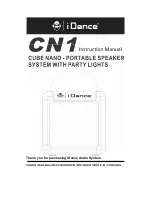
25
Instruction Manual
EL 3000 A Series
EN
Date: 05-30-2017
About the device
1. Introduction
The electronic loads of the series EL3000A are very
efficient devices which offer a big variety of interesting
features at a small form factor. Besides the common func-
tionality of electronic loads you can test batteries, load
voltage or current sources with a pulsed operation, where
the pulse widths and the amplitude are adjustable. Or
you can remotely control the device via an interface card
and control and monitor nearly all its features from a PC.
The integration into existing, remotely controlled systems
is made easy by using one of the interface cards. Their
configuration is intuitive and is done at the device. The
electronic loads can also be controlled and monitored via
the additional analogue interface socket at the rear side,
as well as by any other device with an analogue interface.
The device is microprocessor controlled. This results in
an accurate and fast measurement and display of actual
values, as well as an extended operability by many new
features which wouldn‘t be realisable with standard ana-
logue technology.
The modern design offers highest performance and
enables space-saving conceptioning of complex and
efficient applications, like for example industrial test
equipment with variable powers for different demands
or for demonstration and test purposes in the research
and development area.
Digital control and the retrofittable interface card strongly
simplify the connection to professional, industrial bus sys-
tems like CAN. Almost all features of the single systems
are contained. With USB you can plug and use up to four
(or more) devices to a standard PC without the need of
additional hardware. With CAN you can implement the
devices into existing CAN bus systems without the need to
reconfigure the whole bus. Address range and transmis
-
sions speed can be selected for the particular EL3000A
unit to meet the given requirements.
The main functions at a glance:
•
Set U, I, P and R, each 0...100%
•
Battery test with Ah and time count
•
Pluggable interface cards (CAN, USB, RS232, IEEE/
GPIB, Ethernet/LAN)
•
Analogue interface for external control
•
Pulsed operation between two set values with adjust-
able pulse widths of 50µs...100s with duty cycle, and
adjustable rise/fall time of 30µs...200ms
•
160V at 60A or 400V at 25A and 400W
•
Vector software compatible CAN system
2.
Technical specifications
2.1 Control panel
Type
Display:
two line character LCD with
80
characters
Operating elements: 2 rotary knobs, 2 rotary switches,
1
pushbutton
Display formats
The nominal values determine the adjustable range.
Actual and set values are displayed all at once, as long
as the currently active operation mode allows it.
Display of voltage values
Resolution:
4 digits
Formats:
0.0V…999.0V
Display of current values
Resolution:
3 or 4 digits
Formats:
0.00A…99.99A
Display of power values
Resolution:
4 digits
Formats:
0.0W…999.9W
Display of resistance values
Resolution:
4 digits
Formats:
0.00Ω…99.99Ω
0.0Ω...999.9Ω
Display of time
The elapsed time (only battery test mode) is display in
the format Hours:Minutes:Seconds (HH:MM:SS).
Resolution:
1s
Range:
1s...99h:59m:59s (99:59:59)
This time stamp can be read out via one of the pluggable
interface cards, together with the pulse widths and rise
time of the dynamic Level A/B operation. The dynamic
values can also be set remotely.
Detailed information about this can be found in the user
instruction manual of the interface cards.
















































